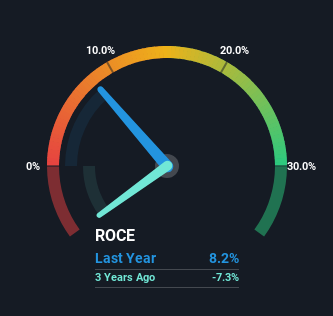- United States
- /
- Energy Services
- /
- NYSE:NOV
Returns On Capital Are Showing Encouraging Signs At NOV (NYSE:NOV)

If you're not sure where to start when looking for the next multi-bagger, there are a few key trends you should keep an eye out for. Firstly, we'll want to see a proven return on capital employed (ROCE) that is increasing, and secondly, an expanding base of capital employed. Basically this means that a company has profitable initiatives that it can continue to reinvest in, which is a trait of a compounding machine. So when we looked at NOV (NYSE:NOV) and its trend of ROCE, we really liked what we saw.
Return On Capital Employed (ROCE): What Is It?
Just to clarify if you're unsure, ROCE is a metric for evaluating how much pre-tax income (in percentage terms) a company earns on the capital invested in its business. To calculate this metric for NOV, this is the formula:
Return on Capital Employed = Earnings Before Interest and Tax (EBIT) ÷ (Total Assets - Current Liabilities)
0.082 = US$738m ÷ (US$11b - US$2.3b) (Based on the trailing twelve months to March 2024).
Therefore, NOV has an ROCE of 8.2%. In absolute terms, that's a low return and it also under-performs the Energy Services industry average of 12%.
Check out our latest analysis for NOV

Above you can see how the current ROCE for NOV compares to its prior returns on capital, but there's only so much you can tell from the past. If you'd like, you can check out the forecasts from the analysts covering NOV for free.
So How Is NOV's ROCE Trending?
NOV has not disappointed in regards to ROCE growth. We found that the returns on capital employed over the last five years have risen by 792%. The company is now earning US$0.08 per dollar of capital employed. In regards to capital employed, NOV appears to been achieving more with less, since the business is using 50% less capital to run its operation. If this trend continues, the business might be getting more efficient but it's shrinking in terms of total assets.
Our Take On NOV's ROCE
In the end, NOV has proven it's capital allocation skills are good with those higher returns from less amount of capital. Given the stock has declined 12% in the last five years, this could be a good investment if the valuation and other metrics are also appealing. So researching this company further and determining whether or not these trends will continue seems justified.
If you'd like to know more about NOV, we've spotted 2 warning signs, and 1 of them is a bit unpleasant.
If you want to search for solid companies with great earnings, check out this free list of companies with good balance sheets and impressive returns on equity.
Valuation is complex, but we're here to simplify it.
Discover if NOV might be undervalued or overvalued with our detailed analysis, featuring fair value estimates, potential risks, dividends, insider trades, and its financial condition.
Access Free AnalysisHave feedback on this article? Concerned about the content? Get in touch with us directly. Alternatively, email editorial-team (at) simplywallst.com.
This article by Simply Wall St is general in nature. We provide commentary based on historical data and analyst forecasts only using an unbiased methodology and our articles are not intended to be financial advice. It does not constitute a recommendation to buy or sell any stock, and does not take account of your objectives, or your financial situation. We aim to bring you long-term focused analysis driven by fundamental data. Note that our analysis may not factor in the latest price-sensitive company announcements or qualitative material. Simply Wall St has no position in any stocks mentioned.
About NYSE:NOV
NOV
Designs, constructs, manufactures, and sells systems, components, and products for oil and gas drilling and production, and industrial and renewable energy sectors in the United States and internationally.
Flawless balance sheet and undervalued.
Similar Companies
Market Insights
Community Narratives



